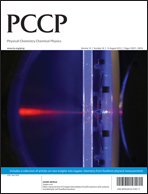The electrochemical formation and dissolution of a lead/copper surface alloy on Cu(100) in chloride-containing electrolyte solutions were studied on the atomic scale by in situ scanning tunneling microscopy with high temporal and spatial resolution. Alloy formation, induced by a negative potential sweep, starts predominantly at the Cu steps, followed by the formation of a novel transient (4 × 3) alloy phase with 0.25 ML Pb coverage, which continuously is transformed into the 0.375 ML coverage c(4 × 4) phase, observed under UHV conditions. Both of these phases consist of rows of Pb atoms embedded into the Cu surface and exhibit highly dynamic structural fluctuations on sub 100 ms time scales. Upon increasing the potential again, a second c(4 × 4) phase with a different appearance in the STM images forms, which is attributed to partial dealloying, involving desorption of Pb from energetically less favorable sites. Further dealloying results in the formation of ribbon-like structures, already reported in previous studies. These ribbons are shown to consist of Pb atoms decorating domain boundaries in the c(2 × 2) chloride adlayer, left behind on the Cu surface by the dissolving surface alloy phase. Furthermore, dynamic observations of the subsequent coarsening of the ribbon network and the attachment/detachment of isolated Pd adsorbates to the ribbons are presented. Both isolated Pb adsorbates and Pb atoms in the ribbons are proposed to be stabilized by coadsorbed Cl.

You have access to this article
 Please wait while we load your content...
Something went wrong. Try again?
Please wait while we load your content...
Something went wrong. Try again?


 Please wait while we load your content...
Please wait while we load your content...